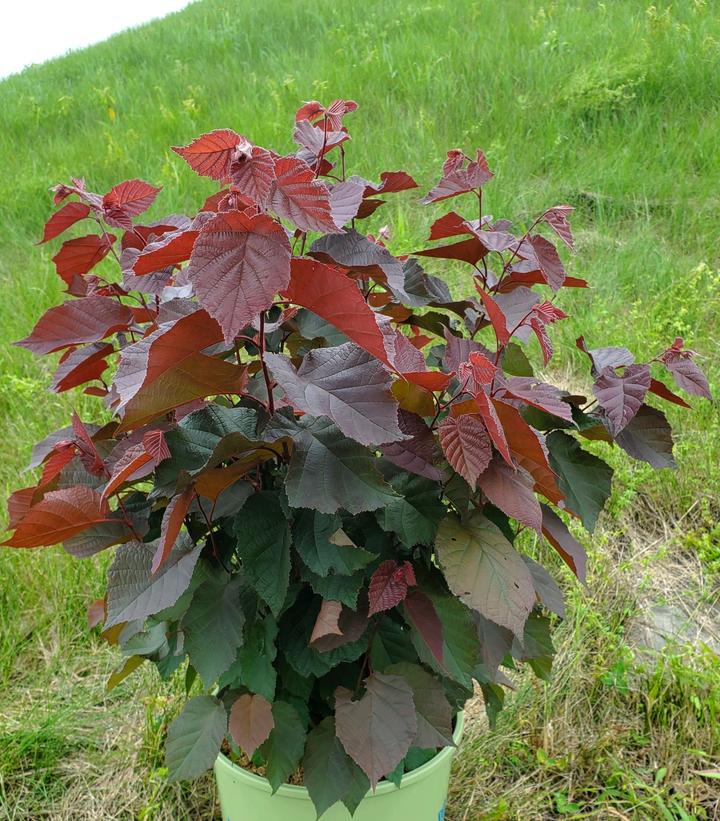Common Name: American Hazelnut
Bloom Time: Early spring catkins (March–April) with edible nuts in late summer to fall
USDA Zones: 4–9 (hardy in Southeastern Wisconsin)
Mature Size: 10–16 ft. tall × 8–13 ft. wide
Habit: Multi-stemmed, rounded shrub or small tree
Foliage: Broad, rounded green leaves with yellow to orange-red fall color
Introduction
A native shrub that offers beauty, wildlife value, and edible rewards, the American Hazelnut (Corylus americana) is a versatile plant for Wisconsin landscapes. With its graceful vase shape, ornamental catkins in spring, and nut clusters ripening by late summer, it brings interest to the garden nearly year-round. For homeowners who want to combine ornamental landscaping with edible gardening, this native shrub is a natural fit.
Though the Purpleleaf Select Hazelnut (Corylus americana ‘Purpleleaf Select’) is currently out of stock at Heritage Hill Nursery, it’s worth keeping on your radar for its ornamental purple foliage paired with all the benefits of our native species.
👉 View Corylus americana ‘Purpleleaf Select’
Origins & Description
The American Hazelnut is native across much of the eastern and central United States, thriving in woodland edges, thickets, and prairies. It is highly adaptable, making it an excellent choice for naturalized areas, edible landscapes, or as a hedgerow plant.
In spring, it produces yellow-brown catkins (male flowers) that dangle from bare stems before the leaves emerge. By late summer, rounded clusters of edible nuts form, each enclosed in leafy husks. These nuts are smaller than those of European hazelnuts but equally delicious, with a sweet, rich flavor prized by wildlife and people alike.
The foliage is broad, slightly heart-shaped, and turns bright yellow to orange-red in fall, adding ornamental appeal to the landscape.
Ideal Growing Conditions (Southeast Wisconsin Focus)
-
Light: Full sun to part shade. Plants in full sun produce more nuts, while part shade works for ornamental plantings.
-
Soil: Tolerates a wide range, from sandy loam to heavier clay. Prefers well-drained, fertile soils.
-
Moisture: Average moisture needs. Established plants tolerate short dry spells.
-
pH: Slightly acidic to neutral soils (6.0–7.0) are ideal.
-
Hardiness: Extremely hardy in Wisconsin winters, reliably surviving subzero temperatures.
Planting & Establishment
When to Plant:
-
Spring (April–May): Excellent time for establishment.
-
Early Fall (September): Allows root development before winter.
How to Plant:
-
Dig a hole twice the width of the root ball.
-
Place the plant at the same depth it was growing in the container.
-
Backfill with native soil and water deeply.
-
Apply a 2–3 inch mulch layer to conserve moisture and suppress weeds.
Pollination Note: Hazelnuts are wind-pollinated and do best when two or more plants are grown together for good nut set.
Care & Maintenance
-
Watering: Provide regular water during the first two years. Once established, hazelnuts are drought-tolerant.
-
Pruning: Minimal pruning needed. Remove crossing branches or suckers in late winter to maintain shape.
-
Fertilization: Apply compost or a balanced fertilizer in early spring if soil is poor.
-
Pests & Disease: Generally low-maintenance. Occasional leaf spots or blight may appear, but rarely serious in home landscapes. Deer and rabbits may browse young shoots, so protection may be needed during establishment.
Propagation
-
Division: Plants can spread by suckering, and these shoots can be transplanted.
-
Seed: Can be grown from nuts, though seed-grown plants may take longer to produce.
-
Cultivars: Named selections like ‘Purpleleaf Select’ offer ornamental foliage and consistent nut quality.
Landscape Uses & Companions
-
Edible Landscapes: Hazelnuts are perfect for permaculture or food forests.
-
Hedgerows: Their dense growth provides natural screening and wildlife shelter.
-
Pollinator & Wildlife Gardens: Early catkins provide pollen for native bees; nuts feed birds, squirrels, and other wildlife.
-
Companions: Combine with serviceberry, viburnum, or native dogwoods for layered wildlife-friendly plantings.
Seasonal Calendar (Wisconsin)
-
March–April: Catkins bloom, providing early-season pollen.
-
May–August: Foliage fills out; nut clusters begin forming.
-
September–October: Nuts ripen; leaves turn bright yellow to orange-red.
-
Winter: Shrubs provide structural interest and wildlife shelter.
Troubleshooting
-
Sparse Nut Set: Often due to lack of cross-pollination. Plant at least two for reliable yields.
-
Poor Growth: Usually from overly wet soils. Ensure proper drainage.
-
Animal Pressure: Protect young plants from deer and rabbits until established.
Ecological & Garden Value
-
Wildlife Habitat: Provides food (nuts) and shelter for birds and mammals.
-
Pollinator Support: Catkins are a valuable early-season pollen source.
-
Native Plant Advantage: Thrives in Wisconsin’s climate with little intervention.
-
Edible Yield: A beautiful shrub that also provides a sweet, nutritious nut crop.
Ready to Plant?
If you’re looking for a native shrub that blends ornamental beauty with practical harvests, the American Hazelnut is an outstanding choice. Perfect for edible landscapes, hedgerows, and wildlife gardens, it’s both functional and attractive.

